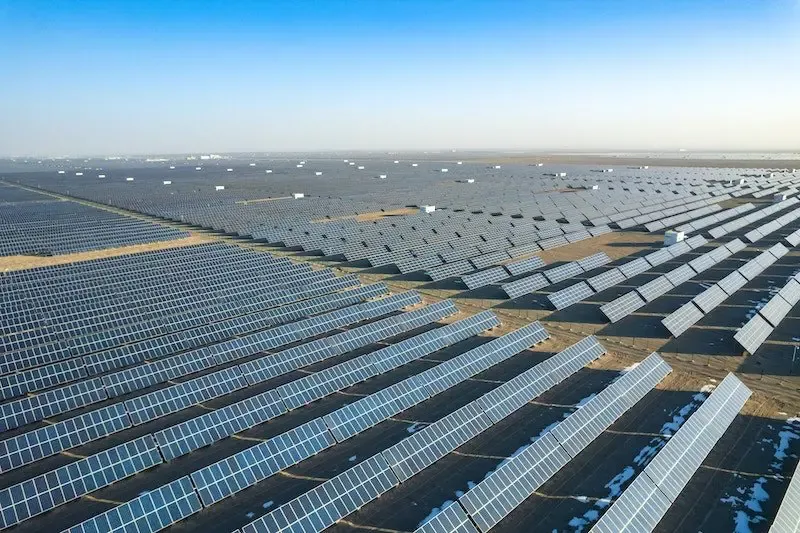Renewable energy deployment is speeding up at an “unprecedented rate” but still falls short of what it will take to hit the tripling of global capacity that countries committed to at last year’s United Nations climate summit, the International Renewable Energy Agency warns in an assessment published earlier this month.
That’s in spite of renewable energy producers installing 473 gigawatts of new capacity last year, accounting for 85% of the new electricity entering the global system, Canary Media reports.
Renewable energy capacity grew 14% last year, contributing to a 10% compound annual growth rate between 2017 and 2023, IRENA says. But it’ll take annual growth of 16.4% to meet countries’ 2030 deadline to triple the amount of renewable energy available around the world by 2030.
“Renewable energy has been increasingly outperforming fossil fuels, but it is not the time to be complacent,” said IRENA Director-General Francesco La Camera. “Renewables must grow at higher speed and scale” unless countries want to “face failure in reaching the tripling renewables target,” thereby putting the climate goals in the 2015 Paris agreement at risk.
The commitment to triple global renewable energy capacity and double the rate of annual energy efficiency improvements by 2030 was one of the signature results of last year’s COP28 climate summit in Dubai. “But IRENA’s analysis found that even if renewables continue to be deployed at the current rate over the next seven years, the world will fall 13.5% short of the target to triple renewables to 11.2 terawatts,” Climate Home News reports.
“Today’s report is a wake-up call for the entire world: while we are making progress, we are off track to meet the global goal,” said COP28 President and fossil fuel CEO Sultan Al Jaber. “We need to increase the pace and scale of development.”
Decarbonization Divide
La Camera added that the top-line numbers obscure “ongoing patterns of concentration in geography” that “threaten to exacerbate the decarbonization divide and pose a significant barrier to achieving the tripling target.” The numbers show Asia leading the world in renewable power generation followed by North America, and South America recording an “impressive jump”, but Africa lagging at just 3.5% annual growth due to a persistent and dire lack of climate finance.
Global Renewables Alliance CEO Bruce Douglas echoed the concern about the imbalances in deployment between regions. “We shouldn’t be celebrating,” he said. “This growth is nowhere near enough and it’s not in the right places."
Even with the aggregate growth data for Asia, Climate Home says, analysis by the REN21 international policy group shows the continent as a whole—excluding renewables powerhouse China—accounting for less than 18% of new capacity additions in 2023.
“The justice piece is huge and too often overlooked,” Douglas said, with IRENA reporting that Africa has seen less than 2% of global renewables investment over the last two decades. “That’s not acceptable in terms of an equitable transition,” he declared.
In the Financial Times, human geographer Brett Christophers of the University of Uppsala’s Institute for Housing and Urban Research cautions against mistaking China’s big numbers on renewable energy deployment for a global trend.
“The view that the world is finally winning in the energy transition away from fossil fuels is increasingly prominent,” he writes. But “comforting as this take may be, we need to throw cold water over it. We are emphatically not yet winning, and it is time to stop pretending that we are.”
‘Hugely Misleading’
It’s “hugely misleading” to look at the global growth rate for renewables when “there is not one single energy transition but a series of regional transitions of widely varying form, pace and scope,” Christophers adds. That matters because “we need rapid growth in renewable investment everywhere,” in every region of the world.
But at present, “the outsized materiality of one—China’s—means global figures veil more than they reveal. They currently look impressive because, and only because, China’s do.”
Elsewhere, the New York Times reports that the U.S. oil industry is still booming, with high prices and recent growth in demand translating into higher profits, even as renewable energy and electric vehicles surge. “That the price and demand for oil have been so strong suggests that the shift to renewable energy and electric vehicles will take longer and be more bumpy than some climate activists and world leaders once hoped,” the Times writes.
While the industry has gained from high prices brought on by the COVID-19 recovery and Russia’s war in Ukraine, the Times lists other factors that have improved oil companies’ prospects: under pressure from Wall Street to offer better financial returns: they’ve become more hesitant to go into debt to pay for new growth, while laying off workers and automating more of their operations. The result is that oil and gas operators in the lower 48 U.S. states have generated US$485 billion in free cash flow since 2021, compared to $140 billion in the previous decade.
“The environmental consequences of the oil industry’s financial turnaround are mixed,” the Times writes, citing Brookings Institution Director Samantha Gross. “Producing and burning fossil fuels releases greenhouse gases that are warming the planet. But higher oil prices are also making cleaner forms of energy more attractive.”














 We publish to analyze metals and the economy to ensure our progress and success in fierce competition.
We publish to analyze metals and the economy to ensure our progress and success in fierce competition.
No comments
Post a Comment